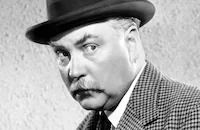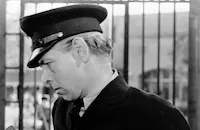The Spider Woman
Brief Synopsis
Cast & Crew
Roy William Neill
Basil Rathbone
Nigel Bruce
Gale Sondergaard
Dennis Hoey
Vernon Downing
Film Details
Technical Specs

Synopsis
With a rash of "pajama suicides" plaguing London, a cry goes out for noted private detective Sherlock Holmes, who is on a fishing vacation in Scotland, to investigate. Holmes quickly deduces that the deaths are actually murders, as no suicide notes have been left by any of the victims, but he tells his friend, Dr. John Watson, that he has decided to retire for heath reasons rather than take on the case. Soon thereafter, Holmes collapses and disappears, and the newspapers are filled with stories of the detective's death by drowning. In actuality, Holmes has faked his own death in order to go undercover to expose the murderous gang, which he suspects is led by a "female Moriarty." Holmes pretends to be an Indian officer named Raghni Singh who, like the previous victims, is a compulsive gambler. Adrea Spedding, the leader of the gang, falls for Holmes's bait and invites him to the Urban Casino, where, after losing all his money and contemplating suicide, he is told by Adrea that he can borrow money on his life insurance policy by making one of her friends his new beneficiary. The next day, however, Adrea discovers Holmes's disguise, and she orders her goons to place a poisonous spider in the air shaft of his apartment. Holmes foils her plot, however, and after killing one of Adrea's accomplices, the detective and Inspector Lestrade of Scotland Yard discover a wooden case and small footprints on the apartment's roof. Later, Holmes and Watson are visited at their Baker Street residency by Adrea and her mute "nephew," Larry. She pretends to be interested in hiring the detective to find her missing friend "Raghni," but as she leaves, Larry throws some candy wrappers into the fireplace, filling the flat with poisonous smoke. Holmes and Watson escape the fumes, however, then go to the home of Matthew Ordway, an eccentric specialist in insects. Holmes soon deduces that the man they meet there is an impostor named Radlik, but he makes his escape by releasing some of Ordway's deadly insects. Holmes and Watson later find the murdered Ordway, as well as the skeleton of a small individual. Holmes quickly realizes that Adrea has been using a pygmy to plant the poisonous spiders in the homes of her victims. Holmes and Watson then go to search for the pygmy at a local carnival, where the detective is soon captured by Adrea and her gang. Holmes is strapped behind a cutout of Adolf Hitler in a shooting gallery, but he escapes his binds just in time to avoid being shot to death by Watson and Norman Locke, Adrea's half-brother. Adrea and her gang are then arrested, and Holmes expresses his respect for the female's evil cunning.

Director
Roy William Neill
Cast

Basil Rathbone

Nigel Bruce

Gale Sondergaard
Dennis Hoey
Vernon Downing
Alec Craig

Arthur Hohl
Mary Gordon
Stanley Logan
Donald Stuart
John Roche
John Burton
Lydia Bilbrook
Belle Mitchell

Harry Cording
John Rogers
Wilson Benge
Teddy Infuhr
Jimmy Aubrey
George Kirby
Marie De Becker
Sylvia Andrews
Angelo Rossitto
Gene Stutenroth
Arthur Stenning
Frank Benson
Crew
William Austin
Howard Benedict
Bernard B. Brown
R. A. Gausman
John B. Goodman
Bertram Millhauser
Paul Neal
Roy William Neill
Martin Obzina
Edward Ray Robinson
H. J. Salter
Melville Shyer
Charles Van Enger
Vera West

Film Details
Technical Specs

Articles
Sherlock Holmes and the Spider Woman - The Spider Woman
At the start of The Spider Woman, London is being swept by a rash of mysterious deaths, nicknamed the "Pyjama Suicides," in which wealthy men are leaping from buildings or putting bullets in their heads without bothering to change out of their sleepwear. When word of the crimes reaches Holmes (on a fishing trip in Scotland), he doesn't for a minute consider them suicides. He suspects there is something more to the crimes: "something monstrous and horrible," he tells Watson (Nigel Bruce), "something that drives these poor fellows to their so-called suicides. And when you drive a man to suicide, that's murder."
Watson urges him to confront the mystery, but Holmes begs off due to illness, and promptly collapses and falls into a raging river. Only for a few minutes is Holmes really presumed dead, for he soon reveals to his devoted assistant that he staged his death as a prelude to infiltrating the mystery of the Pyjama Suicides. From the beginning, he believes a woman to be the source of the crimes, "because the method, whatever it is, is peculiarly subtle and cruel -- feline, not canine."
"Poppycock!" responds the cynical Inspector Lestrade, "Feline, canine, quinine! When a bloke does himself in, that's suicide!"
Holmes's instincts are, of course, correct, and the trail leads to a swank gambling club (The Urban Casino) and the "female Moriarty" at its core: Adrea Spedding (Gale Sondergaard). Posing as a wealthy Indian, Rajnee Singh, Holmes loses his bankroll and exhibits signs of suicidal behavior. Ms. Spedding intervenes and tells him about a life insurance scam that will allow him to regain at least a portion of his fortune.
Holmes goes along with the plan, but Spedding quickly realizes Singh's true identity and begins to orchestrate his demise, first with a venomous spider, then with poisonous gas. Eventually, he is captured by Spedding's henchmen and tied behind a moving target at a shooting gallery -- the very gallery at which Watson is picking up a rifle and taking aim.
Although the opening credits say Bertram Millhauser's screenplay is "based on a story by Sir Arthur Conan Doyle," The Spider Woman is actually an amalgam of ingredients from Holmes's adventures. Doyle enthusiasts have cited no less than five sources of inspiration for the eclectic script: the novel The Sign of the Four, and the short stories "The Adventures of the Dying Detective," "The Adventure of the Final Problem," "The Adventure of the Devil's Foot," and "The Adventure of the Speckled Band." The film was shot under the rather vague working title Sherlock Holmes in Peril.
Continuing the trend that had begun with Universal's Sherlock Holmes and the Voice of Terror (1942), the filmmakers removed Holmes from the fog-shrouded London with which he was commonly associated. The degree to which they wanted to get rid of the old Holmes is revealed in the opening reel of the film, in which Holmes is killed off (or so the viewer is led to believe) and Watson promptly gives away Holmes's personal effects, including the signature Calabash pipe. When Holmes is resurrected, he is very much a modern man and never dons his deerstalker cap and Inverness cape.
The Sherlock Holmes that appears in The Spider Woman is very firmly rooted in the 1940s -- not just by the fashions and styles of automobiles, but in the climactic shooting gallery scene, in which the targets are effigies of Hitler, Mussolini and Hirohito.
Even the studio seemed to want to distance itself from Holmes, omitting his name from the film's title (though The Spider Woman continues to be commonly referred to as Sherlock Holmes and the Spider Woman.
Rathbone and Bruce took a break during production to make a cameo appearance in the comedy Crazy House (1943, starring Ole Olsen and Chic Johnson). In the comedy bit, word is spreading like wildfire across the studio lot about the comedy duo's arrival. When Watson rushes in to inform Holmes (on one of the Spider Woman sets), the sleuth cuts him off. "I know, Watson. Olsen and Johnson are coming." How does he know? "I am Sherlock Holmes," he replies, "I know everything."
The Spider Woman opened to positive reviews for a series film of its ilk. "[The] series is becoming more and more Doyle-ish with each successive edition," wrote Variety, "Current production is an exciting and well worked-out adventure in the career of Sherlock Holmes which brings him as near death as [the] sleuth ever faced."
The Hollywood Reporter proclaimed, "It comes complete with a sterling set of characters and thrills guaranteed to satisfy the most demanding of the Baker Street regulars, and enough excitement to keep the ordinary movie-goer glued to his seat until the villain is snared and Holmes fades into a crowd, spilling philosophy, in search of a new adventure."
In the film's most bizarre twist, the deadly spider (species Lycosa carnivora) is unleashed in Holmes's bedroom by a carnival pygmy who has crawled through the ventilation ducts. Uncredited in the role of "Obongo from the Congo, the Prancing Pygmy" was Angelo Rossitto in blackface. A diminutive character actor best known as one of the vengeance-seeking carnival acts in Tod Browning's Freaks (1932), Rossitto was also familiar to the denizens of Hollywood, where he operated a newsstand for three decades.
Rathbone continued playing the modernized Holmes in six more Universal productions, while Sondergaard reprised her role just once, in the non-Holmes film The Spider Woman Strikes Back (1946).
Director: Roy William Neill
Producer: Roy William Neill
Screenplay: Bertram Millhauser
Based on a story by Sir Arthur Conan Doyle
Cinematography: Charles Van Enger
Production Design: John B. Goodman and Martin Obzina
Music: Hans J. Salter
Cast: Basil Rathbone (Sherlock Holmes), Nigel Bruce (Dr. Watson), Gale Sondergaard (Andrea Spedding), Dennis Hoey (Lestrade), Vernon Downing (Norman Locke), Arthur Hohl (Gilflower), Alec Craig (Radlik), Mary Gordon (Mrs. Hudson).
BW-63m.
by Bret Wood

Sherlock Holmes and the Spider Woman - The Spider Woman
Quotes
Trivia
Notes
The working title of this film was Sherlock Holmes in Peril, and it was also reviewed under the title Sherlock Holmes and the Spider Woman. The Spider Woman was very loosely based on the Sir Arthur Conan Doyle short story, "The Adventures of the Dying Detective" in Strand (Dec 1913). For additional information on the series and other films featuring the Arthur Conan Doyle characters, consult the Series Index and see the entry below for Sherlock Holmes and the Voice of Terror and the entries for Sherlock Holmes and The Hounds of the Baskervilles in the AFI Catalog of Feature Films, 1931-40; F3.4020 and F3.2009. Gale Sondergaard also starred in the 1946 film The Spider Woman Strikes Back (see below), but that picture had no connection to The Spider Woman other than Sondergaard's participation.

Miscellaneous Notes
Released in United States March 1979
Released in United States on Video March 1988
Released in United States Winter January 21, 1944
Released in United States Winter January 21, 1944
Released in United States March 1979 (Shown at FILMEX: Los Angeles International Film Exposition (The 50-Hour Mighty MovieMarathon: Mystery and Suspense) March 14-30, 1979.)
Released in United States on Video March 1988













